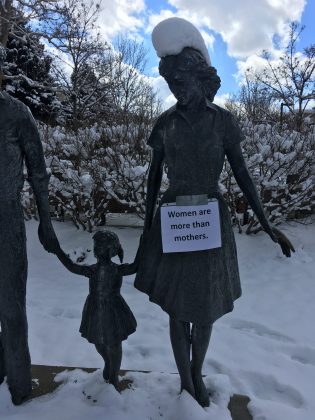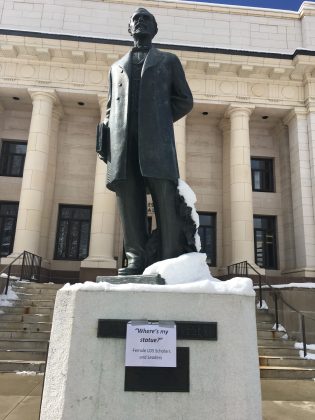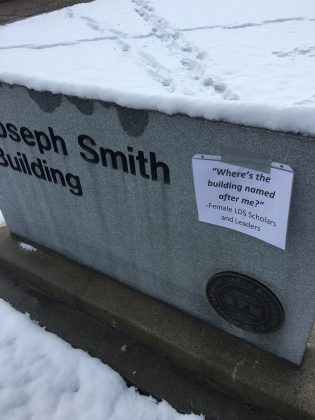Elementary education student Alyson Adams was nervous about completing her guerrilla art project for her ArtEd 326 class, but she knew she wanted to start a conversation. She printed out signs for the project at home, placed them in plastic scrapbook sleeves, packed a roll of duct tape in her lunch bag, and left for campus.
Adams put up signs on campus stating “Women are more than mothers” and “‘Where’s the building named after me?’ — Female LDS Scholars and Leaders” to raise awareness of BYU’s lack of female representation on campus.
Of the 112 buildings listed on BYU’s campus map, three of them are named after women: Amanda Knight Hall, Caroline Hemenway Harman Building, and Helaman Halls’ May Hall.
“It just seems like (women) are almost an invisible population in terms of representation in visible manifestations around campus,” Adams said. “Within our BYU community and church community, we talk about all of these great men who have done wonderful things. But we forget about the women who were there too.”
Art education professor Elicia Gray teaches the course Adams completed the project for. The assignment was to create guerilla art, a street style of art which consists of traditionally anonymous forms of artwork, according to Gray. The two consulted before Adams went forward with the project, agreeing the artwork should be done in a non-aggressive manner.
“(Adams) wanted to explore the idea that she did not see herself or other women in the sculptures around BYU campus,” Gray said. “We talked about ways in which she could invite the viewer to think differently about the sculptures on campus. She wanted students to see what was not there, as well as what was there.”
Adams looped around campus on Feb. 20 at noon, posting signs on different buildings and statues. Her concept for the project focused on the visibility of statues and buildings on campus as students and faculty need to pass by them to get where they need to be.
The sign Adams posted on the “First Child” statue, which features a father and mother with a child, was taken down within 30 minutes. However, the rest of her signs stayed up for the entire day. Campus maintenance workers most likely took them down the next morning. The sign Adams posted in the Harold B. Lee Library was still up on Thursday afternoon.
Some of Adams’ work received physical responses. Someone posted an expired campus map next to Adams’ sign outside the JFSB, highlighting the buildings named after women, most of which are not standing today.
Another person added a note to Adams’ “‘Where’s my statue?’ — Female LDS Scholars and Leaders” post in the library which stated, “Or the buildings named for women?”
Popular Mormon Twitter account @ByCommonConsent responded to a tweet posted by a BYU student showing Adam’s project on campus, which drew attention to the project and caused an online discussion.
???
There are two BYU buildings I can think of named after women. Of over 300. https://t.co/L5FKUCCdWt
— BCC (@ByCommonConsent) February 20, 2018
After Adams saw the positive responses her project was receiving on Twitter, she decided to publicly take credit for it. She shared a post on Facebook along with photos of the signs she placed around campus.
While Adams feels as though the majority of responses have been positive, she’s received several negative responses as well, most of which view her project to be an attack on motherhood as well as the accomplishments of men.
“People turn things like this into political campaigns or political causes,” Adams said. “But this isn’t about politics; it’s about people. We need to represent the women of our past so the women of today can succeed.”
Adams would like to see at least one statue of an LDS woman to mark her accomplishments outside of the home on campus. She believes women like Eliza R. Snow, Zina Huntington Young and Jane Manning James are just some of few with the potential to be honored by the university. If BYU will not name buildings after women or erect new statues in their honor, Adams would like to see more visible reading displays of women’s history around campus.
“By better learning about (LDS women),” Adams said, “we better learn about ourselves and our church history and get a better comprehensive view of who we are as a people and a community.”









